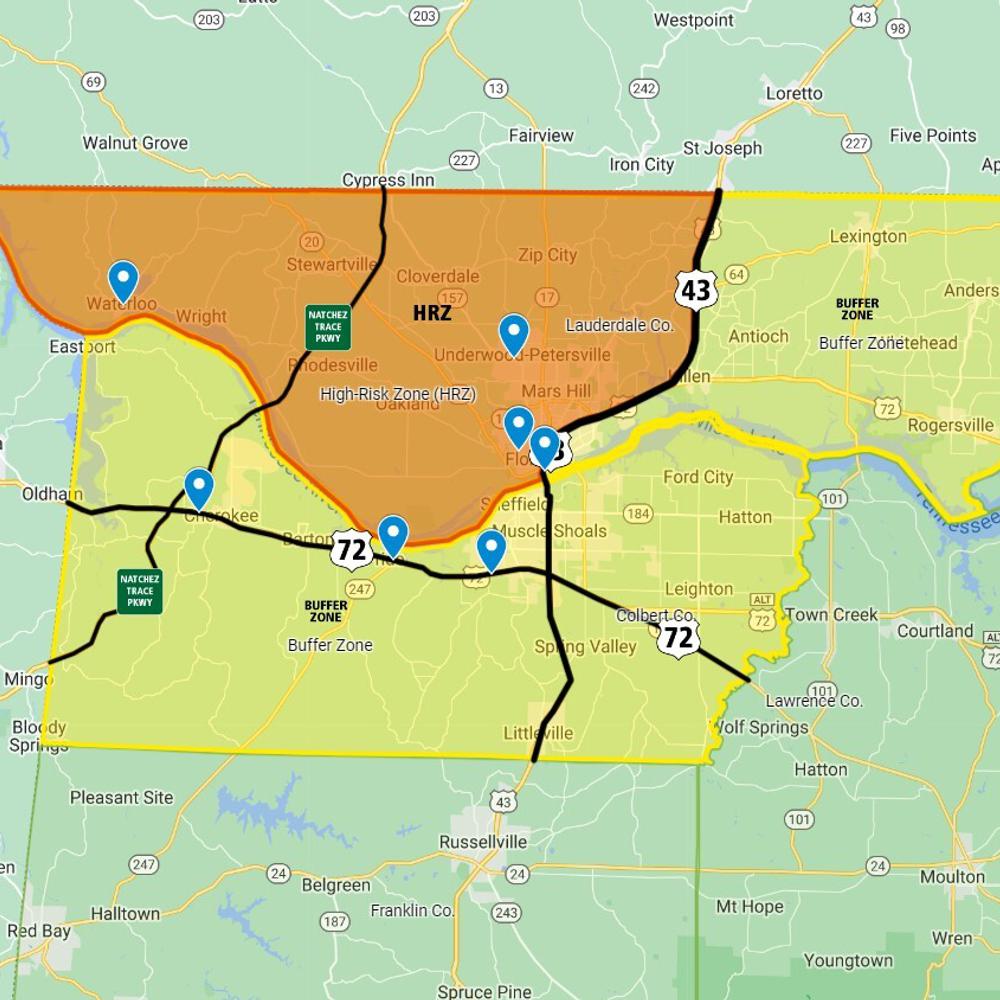As deer season approaches in Alabama, deer meat processors are preparing to face new challenges this year due to chronic wasting disease (CWD).
Chronic wasting disease is a terminal neurological disease that is transmissible and infectious. Symptoms include listlessness, lowering of the head, weight loss, repetitive walking in set patterns and a lack of responsiveness.
The first case in Alabama was discovered on January 6 in the northwest region. A CWD Management Zone (CMZ) was established in Lauderdale and Colbert Counties and with a buffer zone in the surrounding counties in an effort to keep the disease from spreading. (See map below)

Carcass restrictions have been put in place to prohibit the transport of deer from the area. Unfortunately for deer processors in Alabama, this means they may have nowhere to dispose of carcasses this year.
The only company in the state and in much of the southeast that renders carcasses for animal feed rations, BHT ReSources, can no longer accept carcasses from the state because Micah Salsman, general counsel for the company, said there is no way to separate deer from the high-risk areas and those that are from anywhere else.
“That’s the reason we have had to stop taking the material,” said Salsman. “The FDA does not allow material that is at risk of CWD to be included in animal feed rations.”
The rendering process works by separating the fat material and protein material from animal remains. The material is then sent off to other companies for animal feed rations.
Keith Edmonson, who owns Edmonson Deer Processing in Berry, said he has no idea what he is going to do with his 1,700 to 2,000 carcasses this hunting season.
“They’re not picking us up anymore because of the chronic waste disease because it can go into dog food, cat food and those kinds of things,” said Edmonson. “Now we’ve got to find some way to dispose of it, and I don’t know.”
Edmonson said companies have traditionally buried carcasses, but for him, the high volume of material makes that a real challenge.
“It’s going to be kind of aggravating on the deer processors,” Edmonson added. “Big time because we process so many deer a year, and that’s a lot of bones and guts.”
According to Salsman, BHT is losing out on business from clients who pick up its product. However, it is those who they work for, like Edmonson, who will be impacted most.
“We have been the only renderer who has taken this material for years,” Salsman explained. “So, we feel like more than anything else, we provided a service to the processors directly but then also indirectly to all of Alabama’s hunting community.
“ … We feel so badly that we can’t provide this service anymore because we know it’s going to cause a lot of problems.”
The 2022 – 2023 deer season begins October 15 with archery season. Alabama Department of Conservation and Natural Resources’ (ADCNR) Wildlife and Freshwater Fisheries (WFF) Division director Chuck Sykes said in a meeting last week he believes the spread of CWD will slow this year.
“I can’t say we’re not going to find another positive,” Sykes said. “I just hope it’s slow to spread and slow to come in from a different area. Last year, when we announced the positive, there was a lot of speculation and misinformation that was stirred up. After the social media warriors slowed down and took a breath, it settled down. The hunters responded extremely well. They provided the samples needed. I think it went as well as it possibly could have. I’m hopeful this year will be the same. We just want people to be calm.”
In the meantime, the state has offered best practices for the disposal of carcasses within the risk and buffer areas:
Deer carcasses and other unused parts must remain in the management zone where the deer was harvested (HRZ must stay in HRZ, Buffer Zone must stay within CMZ)
Remains should be buried at least two feet deep or deep enough to prevent scavengers from digging up remains.
Burial reduces but does not eliminate the risk of spreading CWD.
If burial is not possible, deer remains may be left on the ground where the animal was harvested. While this will not prevent other deer or scavengers from coming into contact with potentially infected parts, at least those parts will remain in the general area where the deer was taken.
Hunters can take deer harvested in the HRZ to processors and/or taxidermists ONLY within the HRZ.
Hunters can take deer harvested in the Buffer Zone to processors and/or taxidermists located anywhere within the CMZ.
For the latest information on CWD in Alabama, click here.
To connect with the author of this story, or to comment, email erica.thomas@1819news.com.
Don’t miss out! Subscribe to our newsletter and get our top stories every weekday morning.










